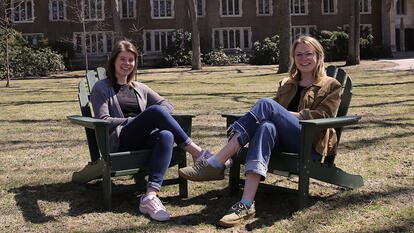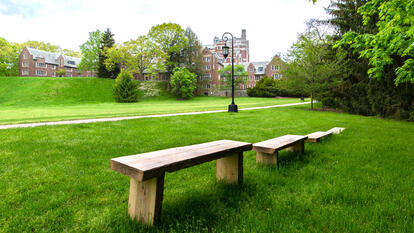The Periodic Table Turns 150: How It Came To Be and What’s Next

The periodic table turned 150 this year, and to mark the milestone, UNESCO and the U.N. General Assembly proclaimed this the “International Year of the Periodic Table of Chemical Elements.”
Chris Arumainayagam, professor of chemistry at Wellesley, calls the table “perhaps the crowning achievement of humanity’s relentless search to discover patterns in our surroundings.”
In September, he traveled to St. Petersburg, Russia, to celebrate the anniversary at the Mendeleev Congress, named for the Russian chemist Dmitri Mendeleev, who is credited with developing the table. Below, Arumainayagam answers questions about the origins and history of the periodic table, how new elements are added, and how its role as a teaching tool has shifted over the past 150 years.
Q: Before the periodic table, were there any similar organizational models, or was it the first?
Chris Arumainayagam: Several scientists, including Dmitri Mendeleev and Lothar Meyer, were working on ordering the elements around the 1860s. Hundreds of different tables have appeared in print since then, but none have endured to the extent that Mendeleev’s has. Interestingly, very recent findings suggest that the periodic table can be recreated based on machine learning methods, which sift through enormous amounts of experimental data to find connections between elements.
Q: Why does Mendeleev get credit for the table?
Arumainayagam: At the time Mendeleev started working on his table, it was known that elements, if arranged according to atomic weight, show periodicity in chemical and physical properties. By adjusting atomic weights to account for possible experimental uncertainties, Mendeleev was able to create a table with far fewer anomalies compared with previous attempts by others. In addition, Mendeleev used his table in 1869 to correctly predict the properties of previously unknown elements, including Germanium and Scandium, years before they were discovered (1886 and 1879, respectively).
Q: Now the table is used more as a teaching tool than a predictive one, and soon, it will be only a teaching tool. Can you explain this evolution?
Arumainayagam: The periodic table, perhaps, best exemplifies what statistician George Box claimed: “All models are wrong, but some are useful.” There are many exceptions to periodic trends, because the underlying principle, electron configuration (e.g., 1s22s22p2 for carbon), is, at best, an approximation. It is wishful thinking to expect quantum mechanics, which governs the properties of elements, to conform to the predictions of the periodic table, which is an organizational tool invented by humans. Nevertheless, the teaching of chemistry would be impossible without the periodic table. The periodic table is to chemistry students as a drafting desk is to architects.
Q: How do new elements get invented?
Arumainayagam: Transmutation of one nucleus to another can be brought about by bombarding a nucleus with energetic particles such as neutrons. Synthesizing new elements is an alchemist’s dream come true! The newly synthesized super-heavy elements are periodic table outliers because these elements involve electrons that travel at speeds close to that of light. Creating and characterizing new elements requires quite astounding technical feats. The search for elements 119 and 120 started this year at the new Russian Superheavy Element Factory (SHEF), whose construction cost over $60 million. Often, only a few atoms of newly synthesized elements are created because, fractions of seconds after they are created, the super-heavy nuclei split into multiple lighter nuclei.
Q: You gave a talk in September at the Periodic Table through Space and Time symposium at the Mendeleev Congress in St. Petersburg that celebrated the anniversary. What was that like?
Arumainayagam: The location was fitting because Dmitri Mendeleev was a professor at the University of St. Petersburg. The talks at this particular symposium ranged from “Big Bang Nucleosynthesis” to “Astrochemistry towards Seeds of Life.” My talk was titled “Cosmic Chemistry: Photochemistry vs. Radiation Chemistry.” In this presentation, I discussed how prebiotic molecules (e.g., glycine) could be formed in ices surrounding microscopic dust grains found in interstellar dark clouds, the birthplace of stars, trillions of miles from Earth.
Q: Do you have a favorite element?
Arumainayagam: Oganesson, the last element in the current periodic table, is my favorite because it is the element that breaks most of the rules that we learn in chemistry. According to the periodic table, this element should be a noble gas (e.g., helium), a monoatomic gaseous substance that has extremely low chemical reactivity. Instead, based on high-level quantum mechanical calculations, Oganesson is predicted to be a semiconductor—a solid substance whose electrical conductivity is between an insulator and a conductor! In addition, the electrons in Oganesson appear to be smeared, and not grouped into shells (orbitals) around the nucleus, like in other elements.
Photo: Two Wellesley students sit in front of a wall-sized Periodic Table of the Elements located in the new L-wing of the Science Center.



